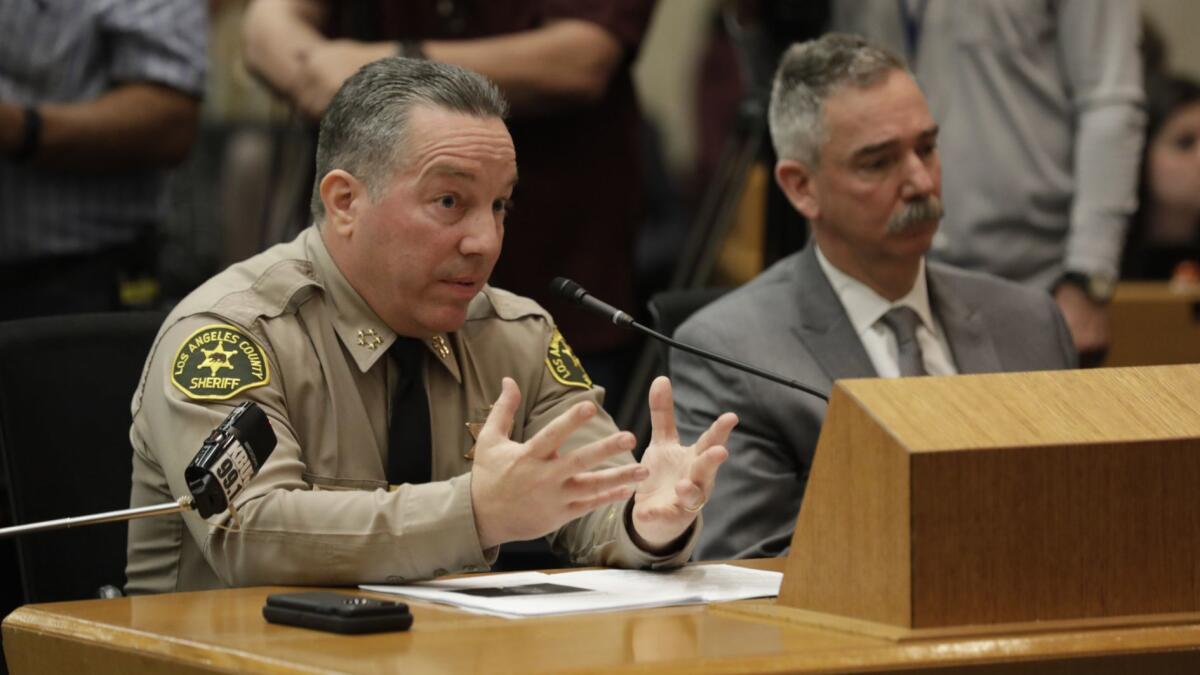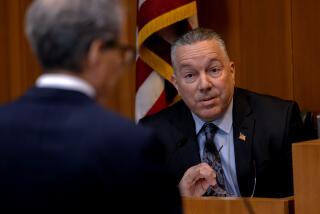Coronavirus is new front in the war between L.A. County’s sheriff and supervisors

Two of Los Angeles County’s most powerful elected officials appeared together in front of a news camera last month to describe ramped-up efforts to battle the coronavirus outbreak.
That evening, Sheriff Alex Villanueva’s phone buzzed with a text from Supervisor Kathryn Barger.
“For what it’s worth: You were great today,” she wrote. “True leadership.”
It’s hard to pinpoint exactly what went wrong after that March 12 show of unity. But the following week, the dynamic between Villanueva and Barger turned hostile, with both throwing punches over control of coronavirus messaging.
It reached a boiling point when the L.A. County Board of Supervisors voted — in a move it said was long in the works — to put the county’s chief executive in charge of its crisis response. In doing so, the board removed Villanueva as the director of the emergency operations center. Villanueva called the move a “silent coup.”
Opinions differ as to how the change will play out. Supervisors and other county officials said it won’t matter much in the day-to-day running of the center, with some describing the move as merely a name swap at the top of an organizational chart.
But Villanueva is indicating that at some point after this crisis he will remove his troops from the center’s operations. He has asked the board to provide a transition plan to replace them.
“If we walked away, a lot of things would fall apart,” Villanueva said. “We’re not going to do that. We want to make sure this thing is done properly from start to finish.”
He added, “We’re going to withdraw at some point.”
The flareup between the board and the sheriff continues a long-running power struggle that began when Villanueva took office in December 2018. But it comes as state, local and federal officials face intense scrutiny over their handling of life-and-death matters in response to the deadly coronavirus outbreak and casts the latest squabbling in a harsh light.
The latest maps and charts on the spread of COVID-19 in California.
It began around the time L.A. County was preparing to issue a stay-at-home order.
Villanueva said he got word of those plans March 19, but the emergency operations center was left out of the loop. He texted Barger, the board’s chairwoman, that afternoon, according to screenshots of the exchange provided by the Sheriff’s Department.
“We need to talk, I’m getting word you are going off-script with L.A. and Long Beach,” he wrote, asking if he should shut down the emergency operations center to avoid duplicative efforts. It was seven days after their joint news conference.
“What is this shadowy decision-making group, and who is in charge?”
Villanueva said he never received a response.
An hour and a half later, Barger announced the order in a live-streamed news conference with Public Health Director Barbara Ferrer and officials from L.A., Pasadena and Long Beach.
“In my wildest dreams, I never anticipated that a supervisor would go rogue and decide to branch off on their own,” Villanueva said in an interview. “That’s uncharted territory.”
Barger said later that the Sheriff’s Department was alerted early that morning to the impending order, and her office provided an email that was sent to two sheriff’s executives who were advised to notify Villanueva.
On a conference call that morning, department heads were asked for their input.
“We got nothing from the sheriff,” Barger said. “To have him say he was left out is a convenient omission on his part.”
Two days after Barger’s news briefing, Villanueva emailed the board and other officials complaining about decisions being made outside the established command structure, and two days after that, he aired similar complaints in a television interview.
It was from that interview, Barger said later, that she learned Villanueva planned to close gun shops during the pandemic, viewing them as non-essential businesses. He went back and forth on the issue, eventually deciding not to enforce the closures after the federal government weighed in, calling the shops essential. He saw the board’s proposal to displace him in the operations center as retaliation for his initial decision to close the gun stores.
Supervisors voted unanimously to approve the change the following week, a move they said stemmed from an audit of the deadly 2018 Woolsey fire that concluded that officials were unprepared for mass evacuations and other disruptions. The audit recommended that the county centralize coordination of its crisis response.
Villanueva and the board then had another dispute, when he asked them to secure retroactive pay for quarantined employees who he said had to dip into their personal sick leave prior to federal benefits kicking in for affected workers. Barger told the sheriff he had the authority to grant employees paid administrative leave. Then, in a sharply worded letter, supervisors further implored him to correct the record after they said his “false information” led to threats against Sachi Hamai, the county’s chief executive.
The county’s emergency operations center was activated March 4, staffed by 100 or so people — including about eight Sheriff’s Department personnel — tasked with coordinating resources to respond to what some have called a once-in-a-generation pandemic.
Day to day, staffers at the operations center might help set up COVID-19 testing centers or inventory the county’s access to N95 masks and other protective gear. They find shelters, food and supplies for people experiencing homelessness and others who have been exposed to the virus but can’t quarantine at home. They handle public messaging and field questions from government officials, businesses and news organizations.
John Stedman, a retired Sheriff’s Department chief who oversaw emergency operations, said that if the sheriff removes his staff, it might require a two-year transition that could include the Office of Emergency Management taking on some of the department’s training duties.
“I don’t know if it’s going to be a plus or minus. It could be a plus if OEM is going to take all that load off the department,” he said. “I don’t understand the move if all you’re going to do is put a different guy in charge.”
A 2012 report suggested that the head of the OEM was better suited than the sheriff to coordinate during an emergency. But the review also found that the OEM was “woefully understaffed,” with 15 full-time workers.
The staff has since doubled, according to Kevin McGowan, who heads the office and was assigned by Hamai to lead the emergency operations center. McGowan said he fully expects to continue working with the Sheriff’s Department.
“The sheriff has a key role to play in law enforcement,” McGowan said. “OEM has a responsibility to provide leadership and support within the emergency management function so these work symbiotically.”
L.A. County sheriffs have led the crisis center since the early 1970s. Since then, significant threats and emergencies have grown more complex. Experts said local government agencies began beefing up staffing and training within disaster response programs after the Sept. 11, 2001, terror attacks.
The L.A. County changes line up with Riverside County’s system, which is headed by the Emergency Management Department. The Sheriff’s Department, meanwhile, staffs the center’s law branch, said county spokeswoman Brooke Federico.
Other counties operate differently. In Ventura County, the Office of Emergency Services — which McGowan headed from 2013 until he was hired last summer by L.A. County — is part of the sheriff’s office. But law enforcement there has taken a backseat in running the response to the coronavirus outbreak.
“The reality is, this is a public health emergency, so our role in it is very limited,” said Ventura County Sheriff’s Capt. Eric Buschow.
In Ventura County, McGowan oversaw the renovation of the emergency operations center and led emergency management for several disasters, including destructive wildfires, the mass shooting at the Borderline Bar and Grill, an oil spill and an explosion at the Santa Clara waste treatment center.
Stewart Gary, a retired fire chief whose audit of the Woolsey fire response triggered L.A. County’s leadership shakeup, said in a statement that law enforcement is “one spoke in the wheel” of an emergency operations center.
“They are really good collaborative partners,” he said. “I would hope that in Los Angeles that would be the case as well.”
More to Read
Sign up for Essential California
The most important California stories and recommendations in your inbox every morning.
You may occasionally receive promotional content from the Los Angeles Times.












